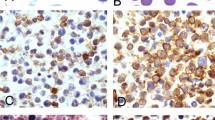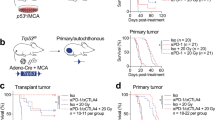Abstract
Kaposi sarcoma (KS) is a vascular tumor that can develop in recipients of solid tissue transplants as a result of either primary infection or reactivation of a gammaherpesvirus, the KS- associated herpesvirus, also known as human herpesvirus-8 (HHV-8). We studied whether HHV-8 and the elusive KS progenitor cells could be transmitted from the donor through the grafts. We used a variety of molecular, cytogenetic, immunohistochemical and immunofluorescence methods to show that the HHV-8–infected neoplastic cells in post-transplant KS from five of eight renal transplant patients harbored either genetic or antigenic markers of their matched donors. These data suggest the use of donor-derived HHV-8–specific T cells for the control of post-transplant KS.
This is a preview of subscription content, access via your institution
Access options
Subscribe to this journal
Receive 12 print issues and online access
$209.00 per year
only $17.42 per issue
Buy this article
- Purchase on Springer Link
- Instant access to full article PDF
Prices may be subject to local taxes which are calculated during checkout




Similar content being viewed by others
References
Antman, K. & Chang, Y. Kaposi's sarcoma. N. Engl. J. Med. 342, 1027–1038 (2000).
Boshoff, C. et al. Kaposi's sarcoma-associated herpesvirus infects endothelial and spindle cells. Nat. Med. 1, 1274–1278 (1995).
Parravicini, C. et al. Risk of Kaposi's sarcoma-associated herpesvirus transmission from donor allografts among Italian post-transplant Kaposi's sarcoma patients. Blood 90, 2826–2829 (1997).
Regamey, N. et al. Transmission of human herpesvirus 8 infection from renal-transplant donors to recipients. N. Engl. J. Med. 339, 1358–1363 (1998).
Luppi, M. et al. Bone marrow failure associated with human herpesvirus 8 infection after transplantation. N. Engl. J. Med. 343, 1378–1385 (2000).
Luppi, M. et al. Molecular evidence of organ-related transmission of Kaposi sarcoma-associated herpesvirus or human herpesvirus-8 in transplant patients. Blood 96, 3279–3281 (2000).
Sarid, R. et al. Detection of human herpesvirus-8 DNA in kidney allografts prior to the development of Kaposi's sarcoma. Clin. Infect. Dis. 32, 1502–1505 (2001).
Papadopoulos, E.B. et al. Infusions of donor leukocytes to treat Epstein-Barr virus-associated lymphoproliferative disorders after allogenic bone marrow transplantation. N. Engl. J. Med. 330, 1185–1191 (1994).
Rooney, C.M. et al. Use of gene-modified virus-specific T lymphocytes to control Epstein-Barr-virus-related lymphoproliferation. Lancet 345, 9–13 (1995).
Kanzler, H. et al. Hodgkin and Reed-Sternberg-like cells in B-cell chronic lymphocytic leukemia represent the outgrowth of single germinal-center B-cell-derived clones: potential precursors of Hodgkin and Reed-Sternberg cells in Hodgkin's disease. Blood 95, 1023–1031 (2000).
Maloney, S. et al. Microchimerism of maternal origin persists into adult life. J. Clin. Invest. 104, 41–47 (1999).
Kruskall, M.S. et al. Survival of transfused donor white blood cells in HIV-infected recipients. Blood 98, 272–279 (2001).
Qian, J. et al. Comparison of fluorescence in situ hybridization analysis of isolated nuclei and routine histological sections from paraffin-embedded prostatic adenocarcinoma specimens. Am. J. Pathol. 149, 1193–1199 (1996).
Dictor, M. & Andersson, C. Lymphaticovenous differentiation in Kaposi's sarcoma. Cellular phenotypes by stage. Am. J. Pathol. 130, 411–417 (1988).
Rabkin, C.S. et al. Monoclonal origin of multicentric Kaposi's sarcoma lesions. N. Engl. J. Med. 336, 988–993 (1997).
Dupin, N. et al. Distribution of human herpesvirus-8 latently infected cells in Kaposi's sarcoma, multicentric Castleman's disease and primary effusion lymphoma. Proc. Natl. Acad. Sci. USA 96, 4546–4551 (1999).
Browning, P.J. et al. Identification and culture of Kaposi's sarcoma-like spindle cells from peripheral blood of human immunodeficiency virus-1-infected individuals and normal controls. Blood 84, 2711–2720 (1994).
Lin, Y., Weisdorf, D.J., Solovey, A. & Hebbel, R.P. Origins of circulating endothelial cells and endothelial outgrowth from blood. J. Clin. Invest. 105, 71–77 (2000).
Peichev, M. et al. Expression of VEGFR-2 and AC133 by circulating human CD34(+) cells identifies a population of functional endothelial precursors. Blood 95, 952–958 (2000).
Rao, A.S. et al. The two-way paradigm of transplantation immunology. Clin. Immunol. Immunopathol. 80 (suppl.), S46–S51 (1996).
Bodo, I. et al. Donor-derived acute promyelocytic leukemia in a liver-transplant recipient. N. Engl. J. Med. 341, 807–813 (1999).
Küppers, R. et al. Tracing B cell development in human germinal centres by molecular analysis of single cells picked from histological sections. EMBO J. 12, 4955–4967 (1993).
Kokova, M. et al. Detection of Y chromosome sequences in Turner's syndrome by Southern blot analysis of amplified DNA. Lancet 342, 140–143 (1993).
Lee, T.-H. et al. Survival of donor leukocyte subpopulations in immunocompetent transfusion recipients: frequent long-term microchimerism in severe trauma patients. Blood 93, 3127–3139 (1999).
Chang, Y. et al. Identification of herpesvirus DNA sequences in AIDS-associated Kaposi's sarcoma. Science 266, 1865–1869 (1994).
Masood, S. et al. Reproducibility of LSI HER-2/neu SpectrumOrange and CEP 17 SpectrumGreen dual color deoxyribonucleic acid probe kit. For enumeration of gene amplification in paraffin-embedded specimens: a multicenter clinical validation study. Ann. Clin. Lab. Sci. 28, 215–223 (1998).
Acknowledgements
This study was supported by the Associazione Italiana per la Ricerca sul Cancro, Milan, Italy (M.L.). We thank G. Santagostino, R. Ricci, L. Bignardi, F. Cardarelli, A. Savazzi, G. Pizov and D. Rubinger for providing the KS biopsies and the clinical data from the renal transplant patients; G. Beduschi for contributing to the microsatellite analysis; and E. Cesarman for enlightening discussion.
Author information
Authors and Affiliations
Corresponding author
Ethics declarations
Competing interests
The authors declare no competing financial interests.
Supplementary information
Rights and permissions
About this article
Cite this article
Barozzi, P., Luppi, M., Facchetti, F. et al. Post-transplant Kaposi sarcoma originates from the seeding of donor-derived progenitors. Nat Med 9, 554–561 (2003). https://doi.org/10.1038/nm862
Received:
Accepted:
Published:
Issue Date:
DOI: https://doi.org/10.1038/nm862
This article is cited by
-
Tumors after kidney transplantation: a population study
World Journal of Surgical Oncology (2023)
-
The lymphatic vascular system: much more than just a sewer
Cell & Bioscience (2022)



